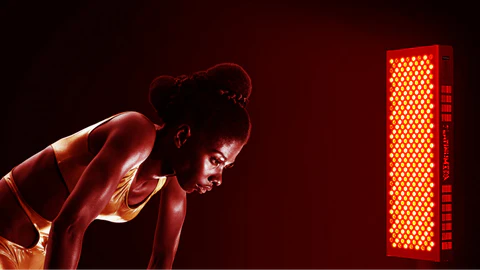Red light therapy can be used in several ways both before and after a workout to prevent injury, improve athletic performance, and accelerate recovery.
What is Red Light Therapy?
Red light therapy uses specific wavelengths of visible red and invisible near-infrared light delivered by powerful LED devices to stimulate healing at the cellular level. It may use red light and near-infrared wavelengths alone or in combination.
Red light therapy is best known as an anti-aging tool, but it is also incredibly versatile as a training tool for athletes of all levels. This includes anyone who likes to go to the gym.
Shorter wavelength red light absorbs into all of the skin’s layers. For muscle recovery, you’ll need longer near-infrared light wavelengths.
Near-infrared light absorbs deep into muscle tissue along with nerves, joints, bones, blood vessels, and other tissues deeper in the body.
How Red Light Therapy Works to Promote Muscle Recovery
Increased Cellular Energy Production
When R+ and NIR+ light absorb into the body, they come into contact with light-sensitive chromophores within the cells. This excites the mitochondria within each cell to produce more energy, stimulating cell regeneration, cellular repair, and resulting in better cellular performance.
When muscle tissue is treated with light, this can translate into to faster recovery from a hard workout, as well as faster recovery from muscle injuries, greater muscle growth, and greater strength and endurance.
Ultimately this can also lead to better muscular performance and improved athletic results, as well as faster recovery time.
Improved Circulation
Red light treatments increase blood flow by stimulating the production of nitric oxide, which is a vasodilator that temporarily dilates blood vessels. Increasing blood flow enhances the amount of oxygen and nutrients going to the muscles.
Red light therapy also stimulates angiogenesis, which is the production of new capillaries. This enhances blood flow to the muscles.
Reduced Chronic Inflammation
Acute (short-term) inflammation, which often manifests as muscle soreness, is a good thing. It means your body is working hard to repair itself after a tough workout.
However, if your muscles are chronically inflamed due to overtraining or an injury, then post-workout muscle pain will linger and performance will decrease.
Red light therapy can reduce inflammation in the muscles and can reduce oxidative stress. This can increase muscle performance during exercise, reduce post-workout pain, and speed up recovery.
Increased Collagen Synthesis
Skin relies on collagen for its structure; and so does muscle tissue. Collagen is a protein that plays a key role in tissue repair and regeneration, and it is essential for muscle growth.
Red light therapy increases collagen production to help muscles rebuild stronger than before. In the muscles, its main function is to provide structural support for healthy muscle tissue.
Pain Relief
Red light is a natural analgesic (pain killer), partly by stimulating the release of endorphins. Tis is the body’s natural opioid-like substance. In a study on chronic low back pain, test subjects’ pain scores fell from 6.9/10 to 3/10 after treatment with red light therapy.
Increased Lymphatic Drainage
Stimulating lymph drainage using red light therapy can help remove lactic acid and toxins from muscles to relieve delayed onset muscle soreness, and speed up recovery.
Muscle contractions are the “pump” that pushes lymph through the body, but red light therapy’s effect on increasing nitric oxide helps lymph flow more freely to remove toxins from muscles.
Red Light Therapy Translates to Faster Return-to-Play!
On a microscopic level, red light therapy supports the healing of torn muscle fibers to rebuild them stronger.
Red light treatment can also result in faster return-to-play. This was found in a large study of university athletes suffering from sports injuries who used red light therapy to return to their sport after an average of 9.6 days as opposed to the anticipated 19.23 days.
How to Use Red Light Therapy for Muscle Recovery
Red Light Therapy Before a Workout: Pre-Condition Muscles and Prevent Injury
Pre-exercise light therapy helps increase ATP production in muscles which results in improved resistance to fatigue as well as reduce muscle damage due to exercise.
Muscles treated with red light therapy show decreased post-exercise levels of creatine kinase, which indicates the level of muscle damage from intense workouts.
Red Light Therapy After a Workout: Speed Up Recovery
If you’ve ever been sore the second day after a hard workout, you’re suffering from DOMS, or delayed onset muscle soreness that occurs 48-72 hours after exercise.
DOMS is a common result of performing novel movements or increasing exercise intensity abruptly – for example, going horseback riding for the first time in years, or adding significant resistance to your weight training routine. DOMS pain delays muscle recovery and can interfere with athletic performance.
In one study, 880nm and 660nm near-infrared and red light therapy were used to treat bicep muscles once a day for five days. The test subjects experienced a significant decrease in DOMS pain.
A similar study that took place over four days showed similar reductions in DOMS pain.
Post-workout red light therapy also increases your muscles’ workload capacity, which can help prevent excessive muscle damage during exercise.
A short pre-workout red light therapy session followed by a short post-workout light therapy session can support your muscles in achieving peak physical performance. This includes athletic performance, injury prevention, and faster exercise recovery.
This article was shared with permission from Platinum Led Therapy Lights. Click here to read the original article.


